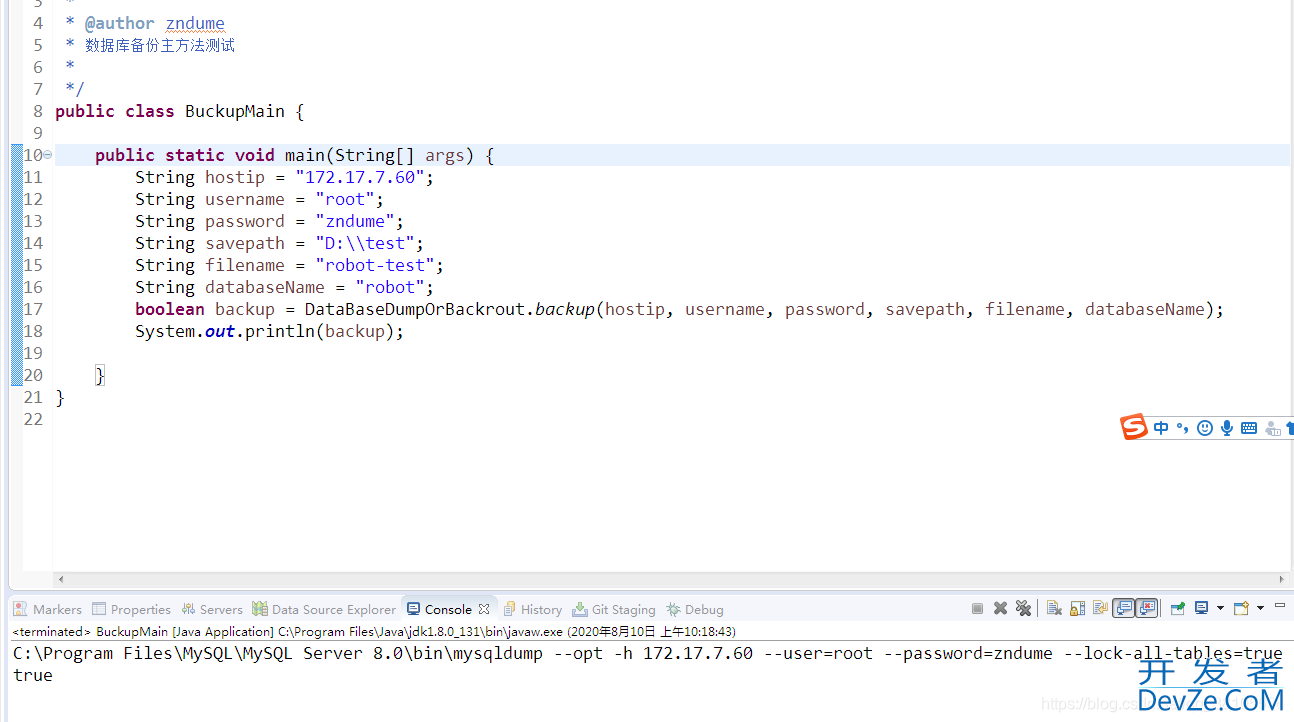Java实现mysql数据库的自动备份和自动还原
在介绍前我要说一下,网上的例子不少,但是坑很多,有些代码看起来是对的,但是小问题不少,原因在于楼主没有测试过,或者没有交代使用时的特殊环境。以下代码都是亲身测试过的。
1.项目背景:使用Java实现远程备份mysql数据库到本地电脑,并可以将本地数据库的备份还原到编程远程mysql数据库。本机环境Windows。
2.注意:本机必须已经装了mysql数据库,并且将mysql 的bin加在了系统环境变量中。我的mysql在c盘,以下代码也是以C盘的mysql的bin下运行的。具体要以你实际安装MYSQL的位置而定,不然就会自己坑自己了。
3.代码逻辑:很重要!!!
4.我们首先(在远程数据库)创建一个有测试数据的库:robot,一个空的数据库(没表,没数据)robot-test。
5.我们第一步将robot数据库备份到本地电脑d:\test,名字命名:robot-test.sql。
6.查看本地电脑的d:\test\robot-test.sql是否存在,并确定是否备份成功。

7.第二步,将robot-test.sql还原到之前创建的空数据库:robot-test。
8.查看robot-test数据库的表和数据是否还原成功。
备份和还原方法写到一个类中:
package com.company;
import java.io.File;
import java.io.IOException;
public class DataBaseDumpOrBackrout {
/**
* @param hostIP ip地址,可以是本机也可以是远程
* @param userName 数据库的用户名
* @param password 数据库的密码
* @param savePath 备份的路径
* @param fileName 备份的文件名
* @param databaseName 需要备份的数据库的名称
* @return
*/
public static boolean backup(String hostIP, String userName, String password, String savePath, String fileName,
String databaseName) {
fileName +=".sql";
File saveFile = new File(savePath);
if (!saveFile.exists()) {// 如果目录不存在
saveFile.mkdirs();// 创建文件夹
}
if (!savePath.endsWith(File.separator)) {
savePath = savePath + File.separator;
}
//拼接命令行的命令
StringBuilder stringBuilder = new StringBuilder();
stringBuilder.append("C:\\Program Files\\MySQL\\MySQL Server 8.0\\bin\\mysqldump --opt -h ").append(hostIP);
stringBuilder.append(" --user=").append(userName).append(" --password=").append(password)
.append(" --lock-all-tables=true");
stringBuilder.append(" --result-file=").append(savePath + fileName).append(" --default-character-set=utf8 ")
.append(databaseName);
System.out.println(stringBuilder.toString());
try {
//调用外部执行exe文件的javaAPI
Process process = Runtime.getRuntime().exec(stringBuilder.toString());
if (process.waitFor() == 0) {// 0 表示线程正常终止。
return true;
}
} catch (IOException e) {
e.printStackTrace();
} catch (InterruptedException e) {
e.printStackTrace();
}
return false;
}
/**
* @param filepath 数据库备份的脚本路径
* @param ip IP地址
* @param database 数据库名称
* @param userName 用户名
* @param password 密码
* @return
*/
public static boolean recover(String filepath,String ip,Strinandroidg database, String userName,String password) {
RMHFDoR
String stmt1 = "C:\\Program Files\\MySQL\\MySQL Server 8.0\\bin\\mysqladmin -h "+ip+" -u"+userName+" -p"+password+" create DATABASE if not EXISTS "+database;
String stmt2 = "mysql -h "+ip+" -u"+userName+" -p"+password+" "+database+" < " + filepath;
String[] cmd = { "cmd", "/c", stmt2 };
try {
System.out.println(stmt1);
Runtime.getRuntime().exec(stmt1);
System.out.println(cmd);
Runtime.getRuntime().exec(cmd);
System.out.println("www.devze.com数据已从 " + filepath + " 导入到数据库中");
} catch (IOException e) {
e.printStackTrace();
return false;
}
return true;
}
}
备份的main方法

package com.company;
/**
*
* @author zndume
* 数据库备份主方法测试
*
*/
public class BuckupMain {
public static void main(String[] args) {
String hostip = "172.17.7.60";
String username = "root";
String password = "zndume";
String savepath = "D:\\test";
String fjsilename = "robot-test";
String databaseName = "robot";
boolean backup = DataBaseDumpOrBackrout.backup(hostip, username, password, savepath, filename, databaseName);
System.out.println(backup);
}
}
还原的main方法

package com.company;
public class RecoverMain {
public static void main(String[] args) {
String ip = "172.17.7.60";
String userName = "root";
String password = "zndume";
String savepath = "D:\\test\\robot-test.sql";
String databaseName = "robot-test";
boolean recover = DataBaseDumpOrBackrout.recover(savepath, ip, databaseName, userName, password);
System.out.println(recover);
}
}
以上就是Java实现mysql数据库的自动备份和自动还原的详细内容,更多关于Java mysql自动备份和自动还原的资料请关注编程客栈(www.devze.com)其它相关文章!





 加载中,请稍侯......
加载中,请稍侯......
精彩评论